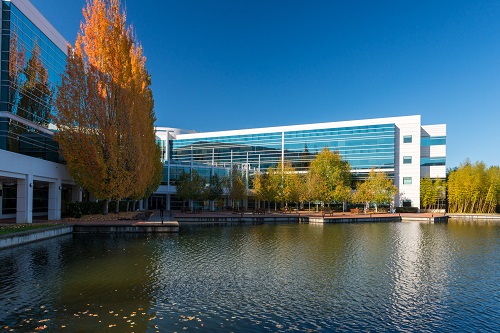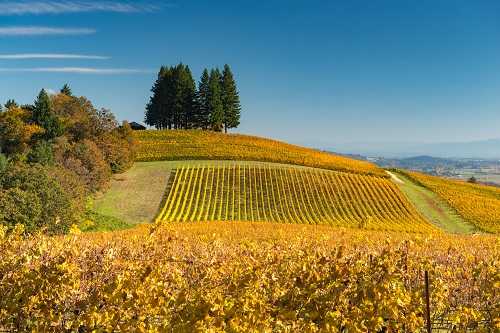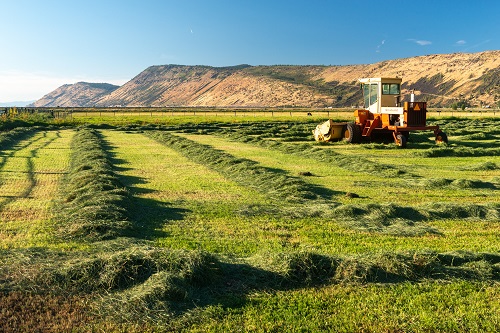
As Oregon's economy shifted from extraction industries to environmental recreation, sportswear companies such as Nike grew rapidly. Show here is the Nike Campus in Beaverton. (Oregon Scenic Images collection)
As Oregon's economy shifted from extraction industries to environmental recreation, sportswear companies such as Nike grew rapidly. Show here is the Nike Campus in Beaverton. (Oregon Scenic Images collection)Those differences in income levels reflected deeper changes to Oregon’s economy, which increasingly shifted away from logging, farming, ranching and other ways of working directly in Oregon’s environments. By the end of the 20th century, the technology industry was booming in Washington County and a few other spots in the state, collectively called the “Silicon Forest.” Some of these companies were homegrown, such as Electro Scientific Industries and Tektronix in the Portland area and Entek International in Lebanon. But Oregon’s technology sector really took off with the arrival of out-of-state businesses, including Hewlett-Packard and Intel in 1976 to Corvallis and Portland, respectively. The Silicon Forest grew as other companies such as Japan’s Fujitsu and Epson arrived in Oregon and smaller companies spun off from Intel, Tektronix and other established businesses. By 2005, nearly 20% of Oregon’s economy came from the technology sector. Reflecting the shift from environmental extraction to environmental recreation, a thriving sportswear industry also developed in Oregon, building on the legacy of Jantzen (established 1916), Columbia (1937) and Nike (1984), as well as Germany-based Adidas. These companies maintained corporate offices and design departments (but not manufacturing facilities) in the Portland area. The Great Recession of 2008 slowed this economic growth—unemployment almost hit 12% in April 2009—but the economic transformations continued, as many other technology, service and consumer-oriented businesses moved to the state and especially to Portland, which grew in national and international popularity as a fashionable place to work, live and play.
 Vineyards and wineries in Yamhill County benefited from the growth of tourism based on Oregon wine. (Oregon Scenic Images collection)
Vineyards and wineries in Yamhill County benefited from the growth of tourism based on Oregon wine. (Oregon Scenic Images collection)In many ways, Oregon’s environments made such growth possible: cheap and abundant water and electricity attracted technology firms, and Oregon’s reputation as a mecca for outdoor recreation drew many other businesses and workers. Building on this reputation as a “Pacific Wonderland”—a license plate slogan originally used in 1959 and reissued in 2010—Oregon’s tourism industry grew dramatically at the end of the 20th and beginning of the 21st century. In 2003, the state legislature created the Oregon Tourism Commission, also known as Travel Oregon, to advertise the state to the nation and world: from adventure-based activities such as mountain biking and windsurfing to more easily accessible car camping at state parks and motorized boating on reservoirs created by river development projects. Other tourist attractions included Oregon’s flourishing wine and craft beer industries, whale-watching and other activities at the Oregon Coast, and shopping, including the Woodburn Premium Outlets, which became a top tourist destination. The growth of tourism represented not only a significant shift in Oregon’s economy, but also in the way that Oregonians perceived and interacted with their environments.
Indian Gaming Regulatory Act
The tourism industry included the state’s casinos, all owned by Oregon tribes—which, like other minorities and women, continued to assert their power and equality in the state’s economy, politics and society. Following the passage of the federal Indian Gaming Regulatory Act in 1988, all nine federally-recognized tribes in Oregon built casinos, beginning with Seven Feathers Hotel and Casino Resort, owned by the Cow Creek Band of Umpqua Tribe of Indians. While paling in comparison to the revenue generated by the state-run Oregon Lottery system, these casinos not only brought tourists and their dollars to the state, but also created employment for local economies, provided funds for charitable work, contributed funds for road and highway improvements and generated revenue and services, including health and educational programs. Such transformations contributed to ongoing efforts to preserve and cultivate Native culture, society, and governance, and the 2010 census counted more than 53,000 American Indians and Alaska Natives in Oregon.

Black Lives Matter protests, such as this one in Bend, were held in many Oregon cities in 2020. (Wikimedia Commons)
Black Lives Matter protests, such as this one in Bend, were held in many Oregon cities in 2020. (Wikimedia Commons)
Minority Populations Grow
Other minority populations in Oregon also grew: nonwhites accounted for 12% of Oregon’s population in 2010, nearly double the percentage of just 20 years before. With a population of more than 450,000 in 2010, Latinx made up the largest minority population in Oregon and played an increasingly important role in state culture and politics. In 1997, Susan Castillo became the first Latina to serve in the state legislature; five years later, she became Oregon superintendent of schools, the first Latina elected to a statewide office. Castillo joined other Oregon women winning important elected offices: Barbara Roberts served as governor from 1991–95, Ellen Rosenblum became the state’s first female attorney general in 2002, and in 2015, Kate Brown became the state’s second female governor and the first openly bisexual governor in the nation. Brown’s ascendancy to the governorship represented in some ways the success of the gay and lesbian rights movement. In 2004, Oregon voters approved Measure 36, which defined marriage as a union between man and woman. But in 2007, the state legislature passed bills permitting same-sex couples to adopt children and prohibiting discrimination based on sexual orientation and gender identity. Measure 36 was reversed in 2015, when the U.S. Supreme Court ruled that bans on same-sex marriage were unconstitutional. Despite this victory for lesbian, gay, bisexual, transgender and queer and/or questioning (LGBTQ) people, minorities and women continued to face discrimination and prejudice in 21st century Oregon. The forces of gentrification in increasingly hip and expensive Portland, as well as neighborhoods in other Oregon cities, priced many Blacks out of their homes, and a vigorous effort in 2020 for racial justice during the Black Lives Matter movement met with a more vigorous police and federal law enforcement response, as well as disdain from some rural residents who imagined lawlessness and anarchy in Oregon’s largest city.
 Tensions between environmentalists, farmers and tribal members over the use of water in the Klamath Basin ran high in the early 2000s. (Oregon Scenic Images collection)
Tensions between environmentalists, farmers and tribal members over the use of water in the Klamath Basin ran high in the early 2000s. (Oregon Scenic Images collection)While the state’s demographics changed, Oregonians continued to grapple with the fundamental question of how they ought to interact with Oregon’s environments. Even with the growth of technology, tourism and other newer sectors of Oregon’s economy, many Oregonians still made their living working directly with Oregon’s fields and forests. In 2015, nearly 35,000 Oregon farms and ranches occupied about 16 million acres and produced more than $5 billion in agricultural products, from the cattle, hay and wheat often grown east of the Cascades to the more specialized products of western Oregon, including filberts, hops, grass seed, landscaping plants, berries, grapes for wine and much more. Although timber production did not reach the historic high levels of the 1960s and 1970s, logging continued and even stabilized to some degree, averaging 4,250 million board-feet between 2000 and 2015, with a notable drop to 2,748 million board-feet in 2009 during the Great Recession. At the same time, the push to preserve and protect Oregon’s environments also continued, driven by the state’s reputation as environmentally-friendly, urban Oregonians’ desire to recreate in non-urban settings, and, for some people, a deeper sense of the intrinsic value of nature. These different ways of interacting with Oregon’s environments produced plenty of tension at the beginning of the 21st century. A particularly heated conflict erupted in the Klamath Basin in 2001, when the Bureau of Reclamation shut off Klamath project irrigation water in an effort to save endangered Coho salmon and two species of sucker fish valued by the Klamath Tribes. This led to a series of public and dangerous confrontations between farmers, federal officials, environmentalists, and tribal members. But the confrontations eventually gave way to conversations and, by 2010, an agreement was made not only to share the Klamath River’s water, but also to remove four older dams to help restore fish habitat. Although the potential for conflict remained, much of the heat of the confrontation dissipated as Oregonians from diverse backgrounds tried to reconcile their different views of Oregon’s environments.